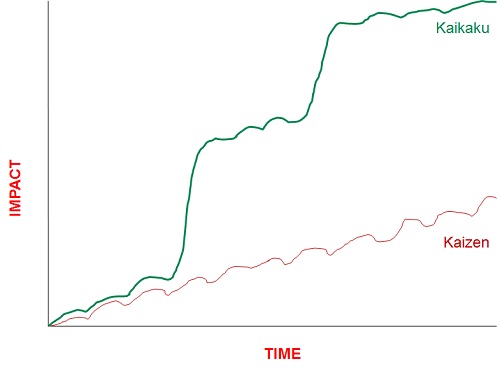
From Kaikaku to Abenomics: When Lean-Kaizen just doesn’t cut it
There’s no doubt that Lean and specifically the idea of Kaizen and its emphasis on continuous improvements have taken off within the manufacturing industry and beyond, influencing industries such as Lean software development and even entrepreneurship with the Lean Start-up movement. The idea has always been part of Lean since its inception within the Toyota Production System, but it didn’t really take off till it got introduced by Masaaki Imai in the mid 1980s. As the Kaizen Institute outlines:
Kaizen is the practice of continuous improvement. Kaizen was originally introduced to the West by Masaaki Imai in his book Kaizen: The Key to Japan’s Competitive Success in 1986. Today Kaizen is recognized worldwide as an important pillar of an organization’s long-term competitive strategy. Kaizen is continuous improvement that is based on certain guiding principles:
- Good processes bring good results
- Go see for yourself to grasp the current situation
- Speak with data, manage by facts
- Take action to contain and correct root causes of problems
- Work as a team
- Kaizen is everybody’s business
- And much more!
One of the most notable features of kaizen is that big results come from many small changes accumulated over time. However this has been misunderstood to mean that kaizen equals small changes. In fact, kaizen means everyone involved in making improvements. While the majority of changes may be small, the greatest impact may be kaizens that are led by senior management as transformational projects, or by cross-functional teams as kaizen events.
And though the idea of big results coming from the accumulation of small changes over time is well known in Lean circles, it seems this idea is not enough. Enter the concept of Kaikaku, which is a concept not as well known as Kaizen but complimentary and perhaps just as important. Kaikaku quite literally means “radical change” and is a fundamental concept that sometimes you need to induce a radical change to a production system to induce growth and increase productivity.

The most interesting idea for us project managers is that Kaikaku is always implemented as a project. As this Wikipedia article outlines, “Kaikaku means that an entire business is changed radically, normally always in the form of a project. Kaikaku is most often initiated by management, since the change as such and the result will significantly impact business. Kaikaku is about introducing new knowledge, new strategies, new approaches, new production techniques or new equipment. Kaikaku can be initiated by external factors, e.g. new technology or market conditions. Kaikaku can also be initiated when management see that ongoing Kaizen work is beginning to stagnate and no longer provides adequate results in relation to the effort. Kaikaku projects often result in improvements in the range of 30-50% and a new base level for continued Kaizen.”
If we were to plot what Kaikaku would look like in relation to Kaizen, it would look something like this:

What this amounts to in my view, is the idea that you need to introduce targeted disruptive interventions to induce a production process, a new product and even an entire organization to radially transform itself. It has parallels with the idea of incorporating an antifragile mindset by which a system benefits from targeted shocks in which “they thrive and grow when exposed to volatility, randomness, disorder, and stressors and love adventure, risk, and uncertainty”, as outlined by the originator of the idea, Nassim Taleb in his book “Antifragile: Things That Gain from Disorder (Incerto)“.
More interestingly, this idea seems to have been adopted by the whole of Japan for which all the ideas of Lean originated. If you look at the economic policies advocated by Shinzō Abe since the December 2012 general election, in which he earned his second term as Prime Minister of Japan, it is an attempt to introduce fiscal stimulus, monetary policy and radical structural reforms to kick-start Japan’s anemic economy. It is affectionately termed “Abenomics” (Abe’s economics). Since the peak of Japan’s economy in the early 1990s in which it experienced a deflationary spiral that are still trying to recover from, all the previous incremental attempts (Kaizen approach) to stimulate the economy back failed. They are now trying to incorporate the radical reforms of Abenomic (Kaikaku approach). The results have been mixed as it initially spurred the economy, but seems it may have been short lived.
In any event, it is interesting that a quality improvement method such as Lean that originated in a country known for their methodical and patient approach to business and life, realize that sometimes in order to improve in a big way means using radical approaches such as Kaikaku. But like any Lean method, this needs to be done through targeted disruptive interventions, rather than just applying shocks to see what happens… that is not to say that the latter couldn’t be beneficial too. 🙂

[…] Don Kim explains the relationship between Kaizen, an operations management incremental improvement process, and Kaikaku, a project delivering radical change. […]
[…] From Kaikaku to Abenomics: When Lean-Kaizen just doesn’t cut it […]